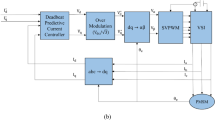Abstract
The paper presents a constant switching frequency scheme for speed sensorless Direct Torque Control (DTC) of Matrix Converter fed Induction Motor Drive. The use of matrix converter facilitates improved power quality on input as well as motor side, along with Input Power Factor control, besides eliminating the need for heavy passive elements. Moreover, DTC through Space Vector Modulation helps in achieving a fast control over the torque and flux of the motor, with added benefit of constant switching frequency. A constant switching frequency aids in maintaining desired power quality of AC mains current even at low motor speeds, and simplifies input filter design of the matrix converter, as compared to conventional hysteresis based DTC. Further, stator voltage estimation from sensed input voltage, and subsequent stator (and rotor) flux estimation is done. For speed sensorless operation, a Model Reference Adaptive System is used, which emulates the speed dependent rotor flux equations of the induction motor. The error between conventionally estimated rotor flux (reference model) and the rotor flux estimated through the adaptive observer is processed through PI controller to generate the rotor speed estimate.





Similar content being viewed by others
References
P.W. Wheeler, J. Rodriguez, J.C. Clare, L. Empringham, A. Weinstein, Matrix converters: a technology review. IEEE Trans. Industr. Electron. 49(2), 276–288 (2002). https://doi.org/10.1109/41.993260
K.B. Lee, F. Blaabjerg, Sensorless DTC-SVM for induction motor driven by a matrix converter using a parameter estimation strategy. IEEE Trans. Industr. Electron. 55(2), 512–521 (2008). https://doi.org/10.1109/TIE.2007.911940
T. Satish, K.K. Mohapatra, N. Mohan, Dynamic performance of a matrix converter fed speed sensorless DTC induction motor drive using adaptive speed observer, in 2009 Twenty-Fourth Annual IEEE Applied Power Electronics Conference and Exposition (2009), pp. 1984–1990. https://doi.org/10.1109/apec.2009.4802945
F.M. Borujeni, M. Ardebili, DTC-SVM control strategy for induction machine based on indirect matrix converter in flywheel energy storage system, in The 6th Power Electronics, Drive Systems Technologies Conference (PED-STC2015) (2015), pp. 352–357. https://doi.org/10.1109/pedstc.2015.7093300
B. Wang, Y. Zhao, Y. Yu, G. Wang, D. Xu, Z. Dong, Speed-sensorless induction machine control in the field-weakening region using discrete speed adaptive full-order observer. IEEE Trans. Power Electron. 31(8), 5759–5773 (2016). https://doi.org/10.1109/TPEL.2015.2496350
B. Bose, Modern Power Electronics and AC Drives (Prentice Hall PTR, Upper Saddle River, 2002)
H. Abu-Rub, A. Iqbal, J. Guzinski, High Performance Control of AC Drives with Matlab/Simulink Models (Wiley, Hoboken, 2012)
A.N. Smith, S.M. Gadoue, J.W. Finch, Improved rotor flux estimation at low speeds for torque MRAS-based sensorless induction motor drives. IEEE Trans. Energy Convers. 31(1), 270–282 (2016). https://doi.org/10.1109/TEC.2015.2480961
Y.B. Zbede, S.M. Gadoue, D.J. Atkinson, Model predictive MRAS estimator for sensorless induction motor drives. IEEE Trans. Industr. Electron. 63(6), 3511–3521 (2016). https://doi.org/10.1109/TIE.2016.2521721
R. Ramchand, K. Sivakumar, A. Das, C. Patel, K. Gopakumar, Improved switching frequency variation control of hysteresis controlled voltage source inverter-fed IM drives using current error space vector. IET Power Electron. 3(2), 219–231 (2010). https://doi.org/10.1049/iet-pel.2009.0020
S. Thuta, Simplified Control of Matrix Converter and Investigations into Its Applications. Ph.D. Thesis, University of Minnesota (2007)
L. Empringham, J.W. Kolar, J. Rodriguez, P.W. Wheeler, J.C. Clare, Technological issues and industrial application of matrix converters: a review. IEEE Trans. Industr. Electron. 60(10), 4260–4271 (2013). https://doi.org/10.1109/TIE.2012.2216231
J.E. Huber, J.W. Kolar, Solid-state transformers: on the origins and evolution of key concepts. IEEE Ind. Electron. Mag. 10(3), 19–28 (2016). https://doi.org/10.1109/MIE.2016.2588878
L. Huber, D. Borojevic, Space vector modulator for forced commutated cyclo- converters, in Conference Record of the IEEE Industry Applications Society Annual Meeting (vol. 1, 1989), pp. 871–876. https://doi.org/10.1109/ias.1989.96746
L. Huber, D. Borojevic, Space vector modulated three-phase to three-phase matrix converter with input power factor correction. IEEE Trans. Ind. Appl. 31(6), 1234–1246 (1995). https://doi.org/10.1109/28.475693
Author information
Authors and Affiliations
Corresponding author
Rights and permissions
About this article
Cite this article
Mir, T.N., Singh, B. & Bhat, A.H. Constant Switching Frequency DTC for Matrix Converter Fed Speed Sensorless Induction Motor Drive. J. Inst. Eng. India Ser. B 99, 527–535 (2018). https://doi.org/10.1007/s40031-018-0336-6
Received:
Accepted:
Published:
Issue Date:
DOI: https://doi.org/10.1007/s40031-018-0336-6




